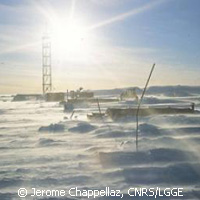Ice cores reveal dramatic variations in biomass burning
An investigation of Antarctic ice cores has uncovered evidence of large variations in levels of vegetation fires in the southern hemisphere over the last 650 years. The findings, published in the journal Science, challenge the common misconception that levels of biomass burning are higher today than in the past. The work was supported in part by the EUROCLIMATE ('Climate variability and (past, present and future) carbon cycle') programme, which falls under the EUROCORES programme of the European Science Foundation (ESF). EUROCORES received support from the EU under the Sixth Framework Programme (FP6). In this study, scientists from France's Centre national de la recherche scientifique (CNRS) and Stony Brook University in the US used a new analytical technique to probe the levels of carbon monoxide (CO) found in bubbles of ancient air trapped within ice cores drilled in the Antarctic's vast ice sheet. Atmospheric CO comes primarily from a small number of sources: the atmospheric oxidation of methane and non-methane hydrocarbons; biomass burning; and fossil fuel combustion. Between them, these sources account for 90% of today's global CO budget. Currently, little is known about how CO levels varied in the pre-industrial era, yet the issue is important because CO affects the climate and atmospheric chemistry through its interactions with methane, ozone and other substances. Scientists can determine the proportion of CO coming from biomass burning by studying the levels of different oxygen isotopes in atmospheric CO. Compared to CO from other sources, CO generated during vegetation fires has a higher proportion of the isotope oxygen 18. 'Combined with concentration measurements of CO, this record allows us to constrain the relative strength of biomass burning activity over the 650-year period in the southern hemisphere,' commented Stony Brook University's John Mak, who led the research. 'What we find is that the amount of biomass burning has changed significantly over that period, and that biomass burning was in fact a significant source of CO during pre-industrial times.' In fact, the ice core revealed that total atmospheric CO concentrations dwindled by around 25% between the mid 1300s and the 1600s, before recovering completely by the late 1800s. Meanwhile, studies of the oxygen isotope signatures in the CO show that biomass burning varied widely over the centuries. According to the researchers, biomass burning decreased by around 50% in the 1600s. However, by the late 1800s it had risen again by approximately 100%. More recently, between the late 1800s and the present day, biomass burning appears to have decreased by some 70%. These findings support other studies that tracked changes in biomass burning through the levels of charcoal particles in sediments. Furthermore, the southern hemisphere record appears to differ significantly from the record in the northern hemisphere, leading to suggestions that some climate models may require updating to take this new information into account. 'While [our result] is consistent with previous findings, there is still a common misperception that biomass burning rates are much higher today than in the past,' noted Professor Mak. 'This is significant since many researchers assume that human-induced biomass burning is much greater than "naturally" occurring biomass burning. While this may still be the case - there were people around in the 18th century - the fact that today's rates of [southern hemisphere] biomass burning seem to be lower than one to two centuries ago calls for a re-evaluation of sources.'
Countries
France, United States

